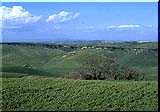|

The
rural landscape
The rural landscape of Etruria was and still is characterized
by a succession of hilly areas covered by thick woods, rich
in water. In the southern part, alongside the hills there
are also lakes of volcanic origin surrounded by mountainous
areas. The distribution of the territory was at the basis
of the birth of the Etruscan people: the borders of property
were considered sacred and inviolable, and accurately marked
by stone blocks. The first agricultural activities were the
cultivation of wheat, barley, millet, broad beans and lentils.
The territory, with abundant grazing land, was also suitable
for livestock raising: the commonest species were cows, pigs
and sheep, to provide food and work and horses, used for transport
and in battle.
Contacts
with Greek culture brought many benefits to agriculture: crop
rotation; the vine was introduced in the 7th century BC, becoming
widespread and producing wines exported throughout the Mediterranean
and from the 5th century BC olive-trees were grown. The Etruscan
territory was famous for its fertility and this was due both
to its geological characteristics and man's intervention.
The Etruscans were in fact capable of major works of civil
engineering, such as aqueducts excavated in the rock, changing
the course of rivers, reclaiming large areas of marshy coastland,
forming a dense network of canals for irrigation purposes
and roads, even built in the sides of mountains.
The
fauna of the inland, hares, boars, birds and deer, that lived
in the wooded areas, provided plentiful game. The forests
also guaranteed the timber necessary to build ships and was
used by the metal industries as fuel. Rich in metals, the
region of the metalliferous hills and the island of Elba were
in fact a very valuable economic resource for the Etruscans,
both from the commercial and military points of view. For
centuries, copper, iron, lead and tin were extracted from
mines located in their lands.
Athletic
games and gladiators
In the rural areas near the cities or sacred areas, athletic
and gladiator games were held in temporary wooden structures,
no traces of which remain. A large public, made up of people
from all social classes and both men and women, gathered for
all these events. We have an accurate idea of these events
from the vast iconography that has come down to us in the
tomb paintings.
Under
the leadership of a judge, whose authority was symbolized
by the same curved stick as used by the priests, the "lituo",
the athletes competed in the most popular sports of the ancient
Mediterranean civilizations, namely throwing the discus and
the javelin, wrestling, boxing, running, high-jumping, pole-vaulting,
running in fighting gear and horse-racing. The most popular
sport however was chariot-racing, with the enthusiasm of the
public reaching levels of fanaticism.
Great
honours were showered on to the winners of the contests, who
received prizes proving their athletic worth before the magistrates
of the city. The gladiators' games also probably attracted
large and demanding audiences. Fighting went on until the
last drop of blood was spilled by slaves, generally prisoners
of war, using a variety of arms and trained in special schools.
As well as men fighting one another, men fighting wild animals
was also common.
|



